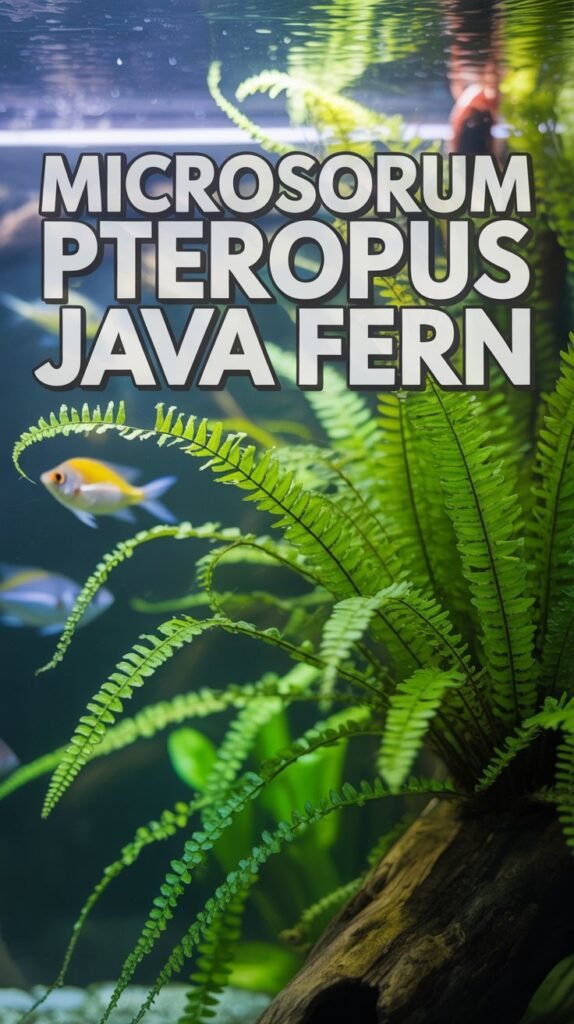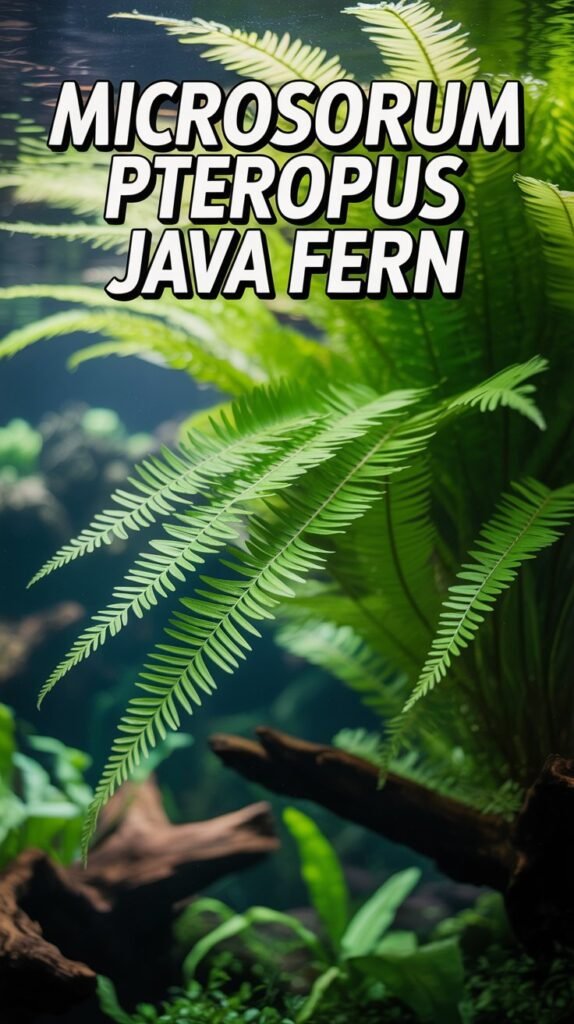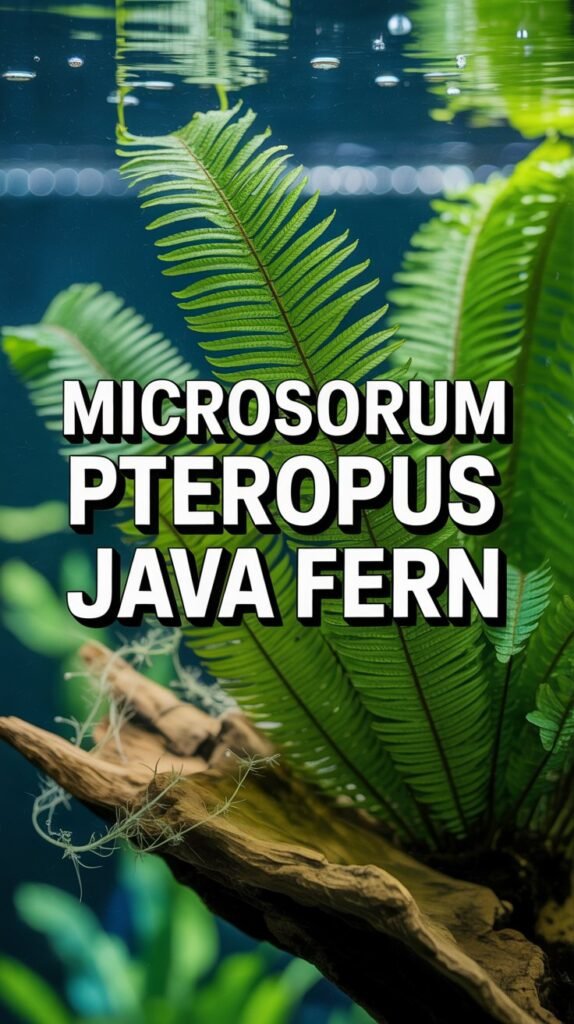If you’re searching for a hardy, low-maintenance, and visually appealing aquarium plant, look no further than Microsorum pteropus, commonly known as Java Fern. This timeless aquatic plant has been a favorite among aquarists for decades, admired for its lush green leaves, adaptability, and ability to thrive in both low-tech and high-tech tanks.
Whether you’re setting up your first planted aquarium or perfecting an elaborate aquascape, Microsorum pteropus (Java Fern) is an ideal choice. In this comprehensive guide, we’ll cover everything you need to know about its origin, appearance, varieties, ideal conditions, propagation, aquascaping potential, and common issues — plus answers to frequently asked questions at the end.
What Is Microsorum Pteropus (Java Fern)?
Microsorum pteropus, or Java Fern, is a species of aquatic fern native to Southeast Asia — particularly Indonesia, Malaysia, and Thailand. It naturally grows along the edges of streams and rivers, where it attaches to rocks, roots, or driftwood.
Belonging to the Polypodiaceae family, Java Fern is a hardy plant that thrives in both fully submerged and partially submerged environments. Its slow growth rate, shade tolerance, and distinctive leaf shape make it a staple in freshwater aquariums.

The name Microsorum pteropus originates from the Greek words:
- “Micros” meaning “small”
- “Soros” meaning “heap” (referring to the reproductive sori on the underside of its leaves)
- “Pteropus” meaning “winged foot,” describing the plant’s spread from its rhizome.
Appearance and Structure
Java Fern has a unique appearance that makes it stand out among aquarium plants. It typically reaches heights of 8–14 inches (20–35 cm), with long, spear-shaped, leathery leaves that vary from bright to dark green depending on lighting and nutrient conditions.
At its base lies a thick rhizome, a horizontal stem that anchors the plant to surfaces and produces both roots and leaves. Unlike rooted plants, Microsorum pteropus should never be buried in substrate, as this will cause the rhizome to rot.
Its leaves often display small black or brown spots on the undersides — these are sporangia (spore clusters), not signs of disease. They are part of the plant’s natural reproductive system.
Natural Habitat and Origin
In the wild, Microsorum pteropus is found in tropical forests of Southeast Asia, thriving in rivers, streams, and waterfalls with slow-moving water. It grows epiphytically — attached to rocks or wood — and receives filtered sunlight through dense forest canopies.
This natural environment has shaped its adaptability, allowing it to survive a wide range of aquarium conditions. Its resilience and shade tolerance are why Java Fern remains a top choice for beginners and professional aquascapers alike.
Varieties of Microsorum Pteropus (Java Fern)
Over time, selective cultivation has produced several unique Java Fern varieties. Each offers subtle differences in leaf shape, size, and growth habit:
1. Microsorum Pteropus ‘Narrow Leaf’
This variety has slim, elongated leaves that grow more upright, creating a vertical flow. Perfect for mid-ground placement or small aquariums.
2. Microsorum Pteropus ‘Windelov’ (Lace Java Fern)
One of the most decorative varieties, featuring finely branched, lace-like leaf tips. It adds intricate texture to aquascapes.
3. Microsorum Pteropus ‘Trident’
Named for its forked leaf tips resembling a trident, this variety has a bushy appearance ideal for foreground or midground use.
4. Microsorum Pteropus ‘Philippine’
Characterized by slightly narrower, longer leaves and a softer green hue. It’s elegant and ideal for minimalistic aquascapes.
5. Microsorum Pteropus ‘Latifolia’
This large-leafed variant has broader leaves and a bolder look, suitable for large tanks and background planting.
Each variety has the same care requirements, so aquarists can mix and match them for diverse, natural layouts.
Benefits of Microsorum Pteropus in Aquariums

Adding Java Fern to your aquarium provides both aesthetic and ecological benefits:
- Low Maintenance: Perfect for beginners; requires minimal lighting and no special substrate.
- Water Purification: Absorbs nitrates and toxins, helping maintain water quality.
- Algae Control: Competes for nutrients, limiting algae growth.
- Shelter for Fish: Provides hiding spots for fry, shrimp, and shy fish.
- Durability: Tough leaves resist nibbling by most fish species.
- Versatile Placement: Can be attached to wood, rocks, or ornaments.
In short, Microsorum pteropus enhances both the beauty and balance of any freshwater aquarium.
Ideal Tank Conditions for Microsorum Pteropus
Although Java Fern can survive in many environments, providing optimal conditions ensures lush, vibrant growth.
Tank Size
- Suitable for any size — from nano tanks to large aquascapes.
- Its slow growth rate makes it easy to manage in smaller setups.
Water Parameters
| Parameter | Ideal Range |
|---|---|
| Temperature | 68–82°F (20–28°C) |
| pH | 6.0–7.5 |
| Hardness | 3–8 dGH |
| Lighting | Low to moderate |
Lighting Requirements
- Java Fern prefers low to medium light.
- High-intensity light can cause algae on the leaves.
- Use soft, indirect lighting for best results.
CO₂ and Fertilization
- CO₂ is optional, not necessary.
- Occasional liquid fertilization (especially potassium and micronutrients) promotes greener leaves.
- Avoid burying root tabs — nutrients should be absorbed through leaves and rhizome.
How to Plant Microsorum Pteropus in Your Aquarium
Java Fern’s unique structure means it must be attached to surfaces, not planted in substrate.
Step-by-Step Planting Guide:
- Choose a base: Driftwood, lava rock, or aquarium décor.
- Position the plant: Place the rhizome on the chosen surface.
- Secure it: Use fishing line, cotton thread, or aquarium-safe glue to hold it in place.
- Allow attachment: Within a few weeks, roots will naturally grip the surface.
- Remove bindings: Once the plant is secure, gently remove thread or line.
This method mimics the plant’s natural environment and ensures healthy, rot-free growth.
Growth Rate and Maintenance
Microsorum pteropus grows slowly, typically producing one or two new leaves per month. However, its hardiness and longevity make it worth the wait.
Maintenance Tips:
- Avoid burying rhizomes: This causes rotting.
- Trim damaged leaves: Use clean scissors to remove yellow or dead parts.
- Clean algae: Gently wipe leaves or introduce algae eaters like shrimp or snails.
- Perform regular water changes: Replace 20–30% of water weekly.
- Fertilize occasionally: Apply liquid fertilizer if leaves appear pale.
Java Fern is resilient — even if parts die back, the rhizome often regenerates new leaves.
Propagation of Microsorum Pteropus

Java Fern is easy to propagate, making it a favorite for aquarists who want to expand their planted tank naturally.
1. Rhizome Division
- Cut the rhizome into sections (each with leaves and roots).
- Attach each new section to a surface.
- Both will grow independently, forming new clusters.
2. Plantlet Formation
- Mature leaves often develop small baby ferns (plantlets) on their tips.
- Wait until the plantlets grow roots and small leaves.
- Separate and attach them to new rocks or wood.
- They’ll mature into full-sized plants over time.
Propagation is slow but steady, rewarding patient aquarists with more greenery.
Common Problems and Solutions
Even hardy plants like Java Fern can face occasional issues. Understanding these problems ensures long-term success.
1. Java Fern Melt
- Symptoms: Leaves turn brown, translucent, or disintegrate.
- Causes: Sudden change in conditions or buried rhizome.
- Solution: Remove decayed leaves; ensure rhizome stays above substrate. New growth will appear soon.
2. Algae on Leaves
- Symptoms: Green or black patches forming on leaves.
- Causes: Too much light or excess nutrients.
- Solution: Reduce lighting duration (6–8 hours/day) and add algae-eating shrimp or snails.
3. Yellow or Pale Leaves
- Symptoms: Leaves fade or turn translucent.
- Causes: Nutrient deficiency, especially potassium or iron.
- Solution: Add a balanced liquid fertilizer designed for aquarium plants.
4. Slow Growth
- Symptoms: Few new leaves forming.
- Causes: Low nutrients, insufficient light, or unstable parameters.
- Solution: Maintain consistent water conditions and gentle lighting.
Aquascaping with Microsorum Pteropus
Java Fern is one of the most versatile plants in aquascaping. Its ability to grow attached to hard surfaces allows aquarists to design creative, natural-looking layouts.
Aquascaping Ideas:
- Background Plant: Place tall ferns in the background for lush, green walls.
- Midground Accent: Attach medium-sized ferns to driftwood for layered textures.
- Epiphytic Displays: Create “fern forests” on driftwood branches or stone crevices.
- Combination Layouts: Pair with Anubias, Cryptocoryne, or Bucephalandra for contrasting shapes.
- Low-Light Tanks: Ideal for shaded areas or setups without CO₂.
Java Fern’s gentle swaying leaves create movement and depth, enhancing the natural atmosphere of the aquarium.
Compatibility with Tankmates
Microsorum pteropus is compatible with nearly all freshwater species, including fish, shrimp, and snails.
Best Tankmates:
- Guppies
- Bettas
- Angelfish
- Gouramis
- Neon Tetras
- Corydoras
- Shrimp (Amano, Cherry, Ghost)
- Snails (Nerite, Mystery)
Avoid:
- Large, aggressive cichlids that may uproot plants.
- Goldfish can tear leaves but typically avoid eating them.
Because of its tough leaves, most herbivorous species ignore Java Fern, making it one of the most durable plants available.
Differences Between Java Fern and Other Aquarium Plants
| Feature | Java Fern | Anubias | Amazon Sword |
|---|---|---|---|
| Lighting | Low–Medium | Low–Medium | Medium–High |
| Growth Type | Epiphytic | Epiphytic | Rooted |
| Maintenance | Very Low | Low | Moderate |
| Ideal Placement | Mid–Background | Fore–Midground | Background |
Java Fern’s adaptability and resilience set it apart, especially for aquarists who prefer low-maintenance aquascapes.
Expert Tips for Best Results
- Attach, Don’t Plant: Always keep the rhizome exposed above the substrate.
- Moderate Lighting: 6–8 hours of soft light daily prevents algae buildup.
- Prune Regularly: Remove old or damaged leaves to promote new growth.
- Be Patient: Growth may be slow at first but becomes steady over time.
- Combine Varieties: Mixing types like ‘Trident’ and ‘Windelov’ creates texture diversity.
With consistent care, Java Fern can live for many years and continuously enhance your aquarium’s beauty.
Final Thoughts
Microsorum pteropus (Java Fern) is a timeless classic in aquarium plant keeping. Its graceful leaves, adaptability, and resilience make it suitable for virtually any freshwater setup. Whether you’re creating a lush jungle aquascape or a minimalist low-light tank, this plant will thrive without demanding constant attention.
It’s more than just a decorative plant — it’s a living ecosystem enhancer, filtering water, supporting fish health, and bringing nature’s tranquility into your aquarium. If you want a beautiful, long-lasting aquatic plant that’s nearly impossible to kill, Java Fern is the one.
FAQs About Microsorum Pteropus (Java Fern)
1. Is Microsorum pteropus easy to grow?
Yes, it’s one of the easiest aquarium plants. It thrives in low light and doesn’t need CO₂ or substrate planting.
2. Can Java Fern survive without CO₂?
Absolutely. It grows well in low-tech tanks without CO₂ supplementation.
3. Why is my Java Fern turning brown or black?
This could be due to rhizome rot, algae growth, or nutrient deficiency. Remove affected leaves and check lighting levels.
4. Should I plant Java Fern in gravel or soil?
No. It should be attached to rocks or driftwood, never buried.
5. How do I propagate Java Fern?
You can divide the rhizome or separate baby plantlets that grow on mature leaves.
6. What lighting does Java Fern prefer?
Low to moderate light works best. High light can cause algae buildup.
7. Can Java Fern grow in a shrimp tank?
Yes. It’s excellent for shrimp tanks — shrimp love hiding among its leaves.
8. How long does it take for Java Fern to grow?
It grows slowly, producing new leaves every few weeks, depending on tank conditions.
9. What are the black dots under Java Fern leaves?
They are sporangia — reproductive spores, not signs of disease.
10. Can Java Fern be used in cold-water aquariums?
Yes. It tolerates temperatures down to about 68°F (20°C), making it suitable for most freshwater tanks.

